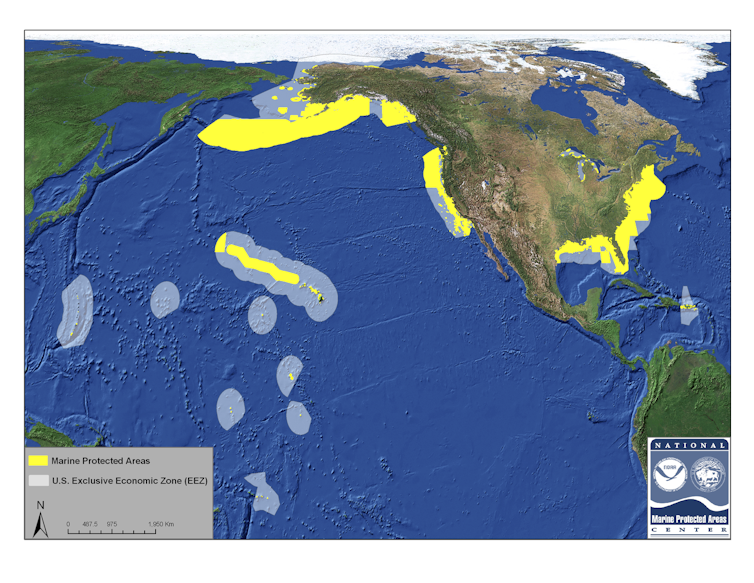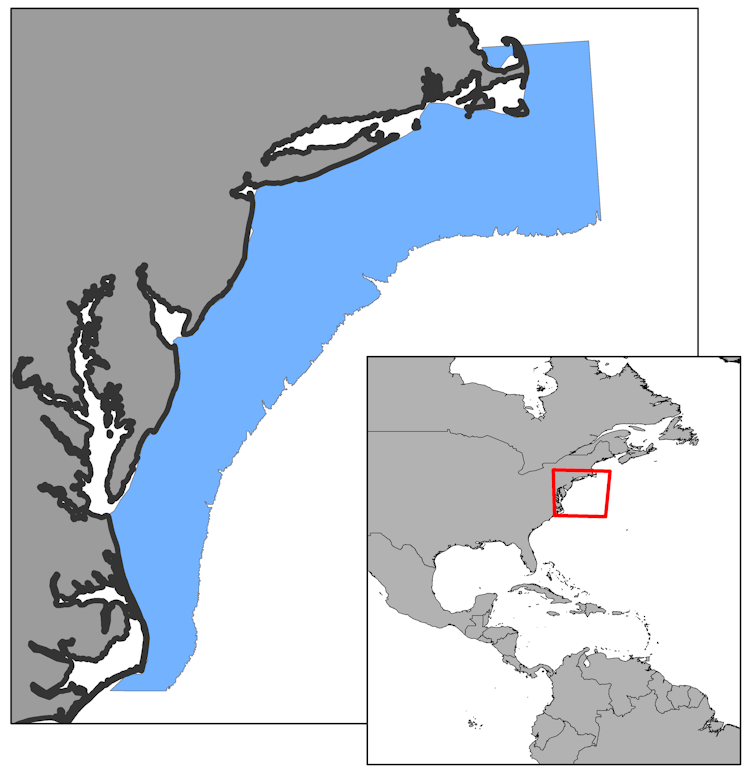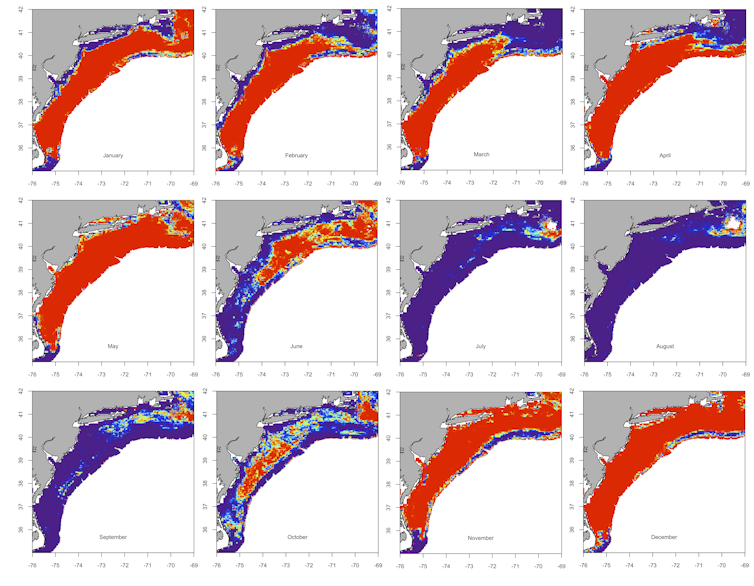To conserve ocean life, marine reserves need to protect species that move around
- Written by Heather Welch, Researcher in Ecosystem Dynamics, University of California, Santa Cruz
This summer, many Americans will visit national parks and wildlife refuges in hope of seeing wild animals, such as bison on the Plains[1] or alligators in the Everglades[2]. Creating protected areas that forbid or manage activities like hunting is an important tool for protecting wildlife.
But it doesn’t always work perfectly. Mobile species, like wolves[3], elk[4] and bears[5], seasonally roam beyond protective park boundaries, where they may be shot[6], hit by cars[7] or put down for straying into urban areas[8].
The challenge is even harder at sea[9]. Fish and other marine species, such as sea turtles, don’t face roads, mountain ranges or other barriers that limit where they can move. What’s more, suitable habitat for many marine species is governed by factors that change with the seasons, such as currents, fronts and eddies. This means that the distribution of marine species can vary a lot from month to month.
We study ocean habitats[10] and strategies for conserving ocean life[11]. In analyzing marine protected areas, we’ve concluded that simply designating protected zones is not enough. To be effective, these areas must be designed to take more account of how sea life moves in and out of their boundaries.
 U.S. marine protected areas (yellow) occupy about one-fourth of the nation’s territorial waters.
NOAA[12]
U.S. marine protected areas (yellow) occupy about one-fourth of the nation’s territorial waters.
NOAA[12]
Underwater parks
Over the past century, the United States has created[13] over 1,200 marine protected areas[14] covering 26 percent of its national waters. These zones are designed to safeguard important undersea ecosystems, such as coral reefs[15], and the creatures that depend on them.
More than one-fourth of these areas[16] are concentrated in the mid-Atlantic between Massachusetts and North Carolina. These reserves were designed to protect static features, such as sensitive bottom habitat[17] and nursery grounds.
 The U.S. mid-Atlantic region.
Heather Welch, CC BY-ND[18]
The U.S. mid-Atlantic region.
Heather Welch, CC BY-ND[18]
In a study[19], we assessed how well marine protected areas in this zone accommodated the movements of marine species. To do this we built species distribution models for 171 marine species that occur in the mid-Atlantic.
For each species, we acquired records for where it had been caught by a trawl net during regular surveys performed by the NOAA National Marine Fisheries Service[20]. Then, using satellite[21] and ocean model data[22], we determined the environmental conditions at each of these locations, using variables like temperature and salinity. This process showed us, for example, that dogfish prefer zones with water temperatures between roughly 5 and 15 degrees Celsius and specific salinity levels. These relationships between species and the environment are called species response curves.
Since we were interested in how species move seasonally, we wanted to know where they were likely to be in each month. Using data from satellites and ocean models and our response curves, we predicted monthly distributions for each of our 171 species in the mid-Atlantic.
 Monthly predictions of dogfish distribution. Dogfish are most likely to be found in red areas and least likely to be found in purple areas.
Heather Welch, CC BY-ND[23]
Monthly predictions of dogfish distribution. Dogfish are most likely to be found in red areas and least likely to be found in purple areas.
Heather Welch, CC BY-ND[23]
To make this huge quantity of data manageable, we clustered the species predictions into monthly assemblages – large multi-species clusters that tended to form in certain areas. Our species grouped in ways that produced between five and 11 of these large assemblages each month across the mid-Atlantic region, for a total of 85 large marine species groupings throughout the calendar year.
For example, lobster, bluefish and striped bass move together from a northern assemblage inshore in the summer to a southern assemblage in the winter to stay in consistent water temperatures.
Then we looked to see what fraction of our 85 assemblages of marine species were adequately conserved within protected areas. In 2010, nations that are members of the international Convention on Biodiversity set a target[24] calling for marine reserves to protect 10 percent of the world’s coastal and marine areas[25], especially zones that are critically important for biodiversity. But when we examined the most strictly enforced marine protected areas in the mid-Atlantic – those that restrict or prohibit commercial fishing – we found that they fell far short of this goal.
Among the 85 marine species assemblages in our study that formed at various times during the year, only 36 had at least 10 percent of their preferred habitat protected within marine reserves. For the remaining assemblages and the marine species they contained, less than 10 percent of their preferred habitat fell inside marine reserves.
Redesigning protected areas
How could marine protected areas be improved to protect mobile species more effectively? To answer this question we used specialized reserve design software called Marxan[26]. Marxan works by finding spatial solutions that maximize targets for marine biodiversity protection – in this case, protecting 10 percent of each assemblage’s preferred habitat – while minimizing cost. In this analysis the cost was represented by marine protected area size: The larger a marine protected area is, the more extractive uses such as fishing will be barred or restricted within it, and these limits represent opportunity costs for fishermen.
The areas that our Marxan solutions focused on protecting were offshore at the edge of the continental shelf – the relatively shallow seafloor adjacent to the coastline. Many species move across the shelf seasonally, exploiting productive inshore waters during summer months and then moving offshore to deeper and more stable waters in winter. Existing marine protected areas that are strictly enforced are generally located inshore, so when marine species move out toward the edge of the continental shelf, they move out of the protected zones.
Our work shows that if species protection is a primary goal, the mid-Atlantic needs a new configuration of marine protected areas that take species’ seasonal movements into account. Complex dynamic features like these are unlikely to be protected unless they are explicitly planned for[27] when marine protected areas are designed.
Many coastal nations have created marine protected areas, but so far they cover just 3 percent of the world’s oceans.Should marine protected areas move around with sea life?
Other studies have also proposed[28] designs for protected areas that manage dynamic features such as seasonally mobile species. Now some scientists are suggesting that it would be more efficient to make the protected areas themselves movable.
Dynamic ocean management[29] is an emerging approach that makes protected area boundaries flexible in space and time, so that they can track the dynamic features they are designed to manage. For example, an interdisciplinary group of researchers is working on a tool[30] for the U.S. West Coast in which boundaries are updated each day to protect turtles, sharks and sea lions from unwanted interactions with fishing vessels. They have shown that this approach would actually close off less territory to fishermen, while protecting key species more effectively.
This is a new strategy[31] that has been applied in only a few locations[32], but it looks to be a viable approach for protecting mobile marine species. In a world where climate variability and change are accelerating, society’s approach to marine conservation needs to change with it.
References
- ^ bison on the Plains (www.nps.gov)
- ^ alligators in the Everglades (www.nps.gov)
- ^ wolves (www.nytimes.com)
- ^ elk (billingsgazette.com)
- ^ bears (www.huffingtonpost.com)
- ^ shot (www.npr.org)
- ^ hit by cars (billingsgazette.com)
- ^ straying into urban areas (idahostatejournal.com)
- ^ even harder at sea (doi.org)
- ^ ocean habitats (scholar.google.com)
- ^ conserving ocean life (scholar.google.com)
- ^ NOAA (marineprotectedareas.noaa.gov)
- ^ created (noaa.maps.arcgis.com)
- ^ marine protected areas (marineprotectedareas.noaa.gov)
- ^ coral reefs (flowergarden.noaa.gov)
- ^ one-fourth of these areas (nmsmarineprotectedareas.blob.core.windows.net)
- ^ sensitive bottom habitat (www.greateratlantic.fisheries.noaa.gov)
- ^ CC BY-ND (creativecommons.org)
- ^ study (doi.org)
- ^ NOAA National Marine Fisheries Service (www.fisheries.noaa.gov)
- ^ satellite (www.nnvl.noaa.gov)
- ^ ocean model data (hycom.org)
- ^ CC BY-ND (creativecommons.org)
- ^ target (www.cbd.int)
- ^ 10 percent of the world’s coastal and marine areas (www.cbd.int)
- ^ Marxan (marxan.org)
- ^ explicitly planned for (dx.doi.org)
- ^ proposed (citeseerx.ist.psu.edu)
- ^ Dynamic ocean management (dx.doi.org)
- ^ tool (dx.doi.org)
- ^ new strategy (www.sciencedirect.com)
- ^ few locations (www.afma.gov.au)
Authors: Heather Welch, Researcher in Ecosystem Dynamics, University of California, Santa Cruz

